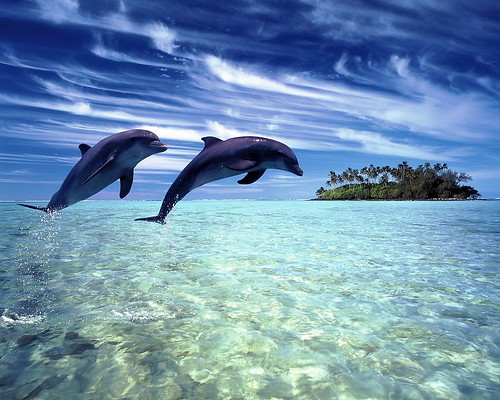Dolphins have been declared the world’s second most intelligent creatures after humans, with scientists suggesting they are so bright that they should be treated as “non-human persons”.
Studies into dolphin behaviour have highlighted how similar their communications are to those of humans and that they are brighter than chimpanzees. These have been backed up by anatomical research showing that dolphin brains have many key features associated with high intelligence.
The researchers argue that their work shows it is morally unacceptable to keep such intelligent animals in amusement parks or to kill them for food or by accident when fishing. Some 300,000 whales, dolphins and porpoises die in this way each year.
“Many dolphin brains are larger than our own and second in mass only to the human brain when corrected for body size,” said Lori Marino, a zoologist at Emory University in Atlanta, Georgia, who has used magnetic resonance imaging scans to map the brains of dolphin species and compare them with those of primates.
“The neuroanatomy suggests psychological continuity between humans and dolphins and has profound implications for the ethics of human-dolphin interactions,” she added.
Dolphins have long been recognised as among the most intelligent of animals but many researchers had placed them below chimps, which some studies have found can reach the intelligence levels of three-year-old children. Recently, however, a series of behavioural studies has suggested that dolphins, especially species such as the bottlenose, could be the brighter of the two. The studies show how dolphins have distinct personalities, a strong sense of self and can think about the future.
It has also become clear that they are “cultural” animals, meaning that new types of behaviour can quickly be picked up by one dolphin from another.
In one study, Diana Reiss, professor of psychology at Hunter College, City University of New York, showed that bottlenose dolphins could recognise themselves in a mirror and use it to inspect various parts of their bodies, an ability that had been thought limited to humans and great apes.
In another, she found that captive animals also had the ability to learn a rudimentary symbol-based language."
source
Blog

- MARIA H
- Compilation of aesthetic manifestations beyond compliance, bring us emancipation.
Archive
-
▼
10
(186)
-
▼
Feb 2010
(49)
- Million Dollar Hotel
- Omahyra Mota / Ellen von Unwerth
- , originally uploaded by parallel entity.
- , originally uploaded by parallel entity.
- McGinley / Swinton
- Vogue italia now has 3 zones
- horizontal view
- ecofeminist ethics
- Gustave Dore Les saltimbanques -1874
- Mirror
- Scientists say dolphins should be treated as 'non-...
- Dali playing
- Federico Garcia Lorca
- Koolhaas HouseLife
- Caribou
- apricot
- Jen Ray Amazons
- Calvin and Hobbes on ethics
- Found image : down under
- polina kouklina
- Jacques Dequeker
- , originally uploaded by parallel entity.
- Editorial: Enemy
- Feminine landscape
- The Row
- .
- , originally uploaded by parallel entity.
- Mathew Ames FW2010
- , originally uploaded by parallel entity.
- , originally uploaded by parallel entity.
- girly is goodness
- Crochet animals
- , originally uploaded by parallel entity.
- , originally uploaded by parallel entity.
- Starry
- Rad Hourani: Somewhere between Owens and Margiela
- No title
- , originally uploaded by parallel entity.
- the color of the pomegranates- Parajanov
- Sergei Parajanov- Armenian master
- Draco Rosa nostalgia
- Chanel Cruise 2010
- Dan Perjovschi
- domesticated underwear
- sad
- , originally uploaded by maquisin.
- dormant
- Deja- Sidestepper
- Augmented stuff perception
-
▼
Feb 2010
(49)

